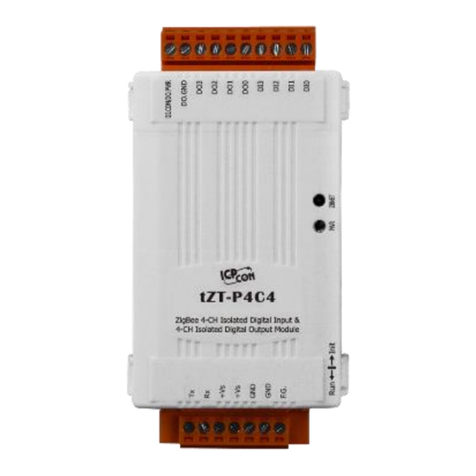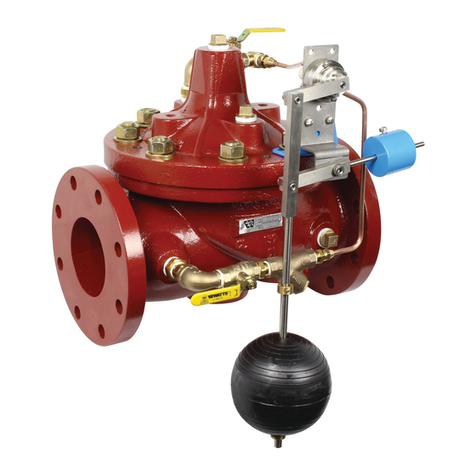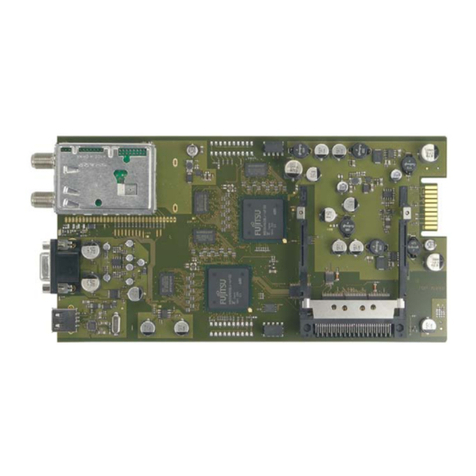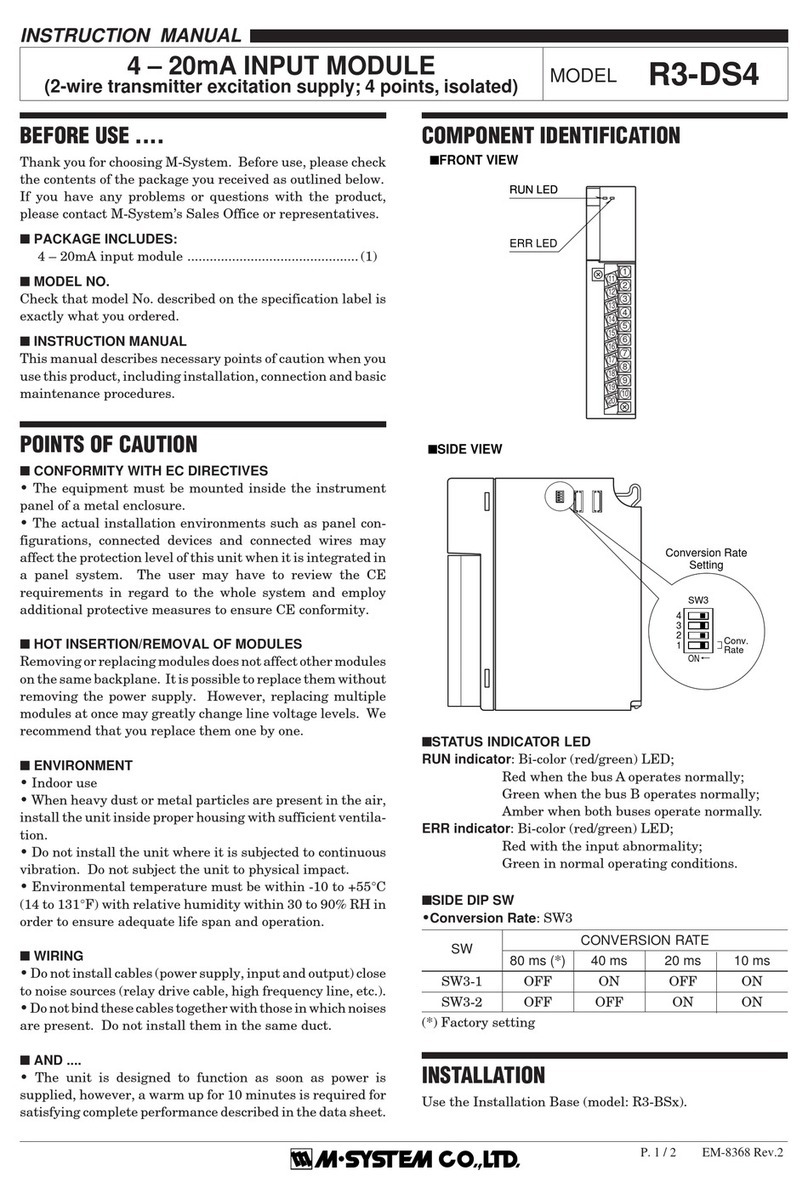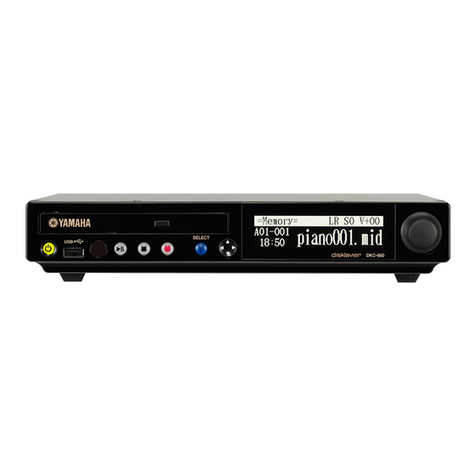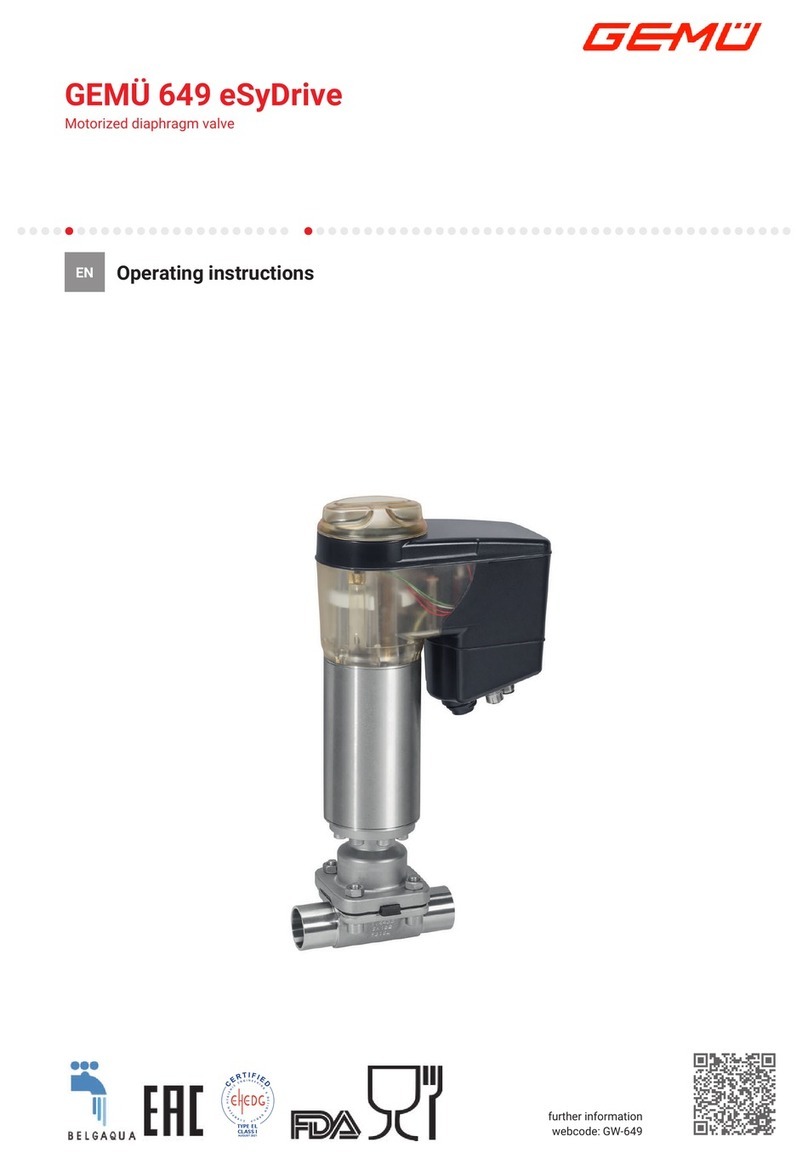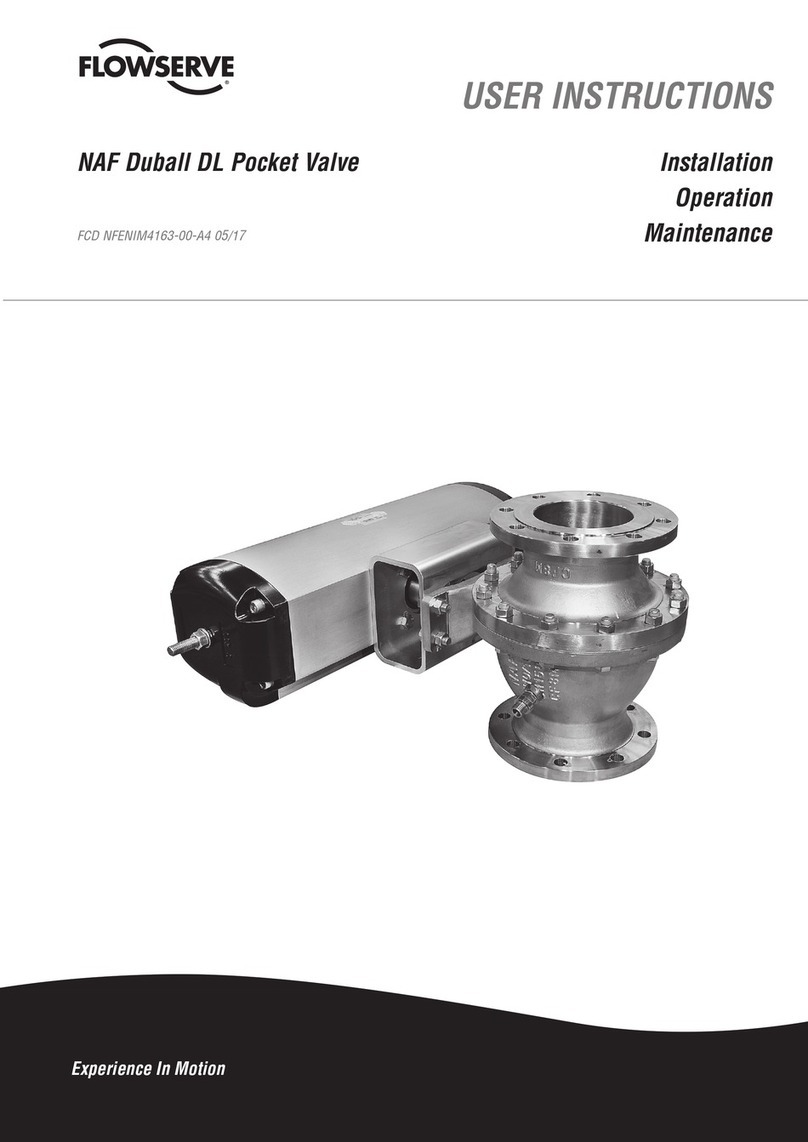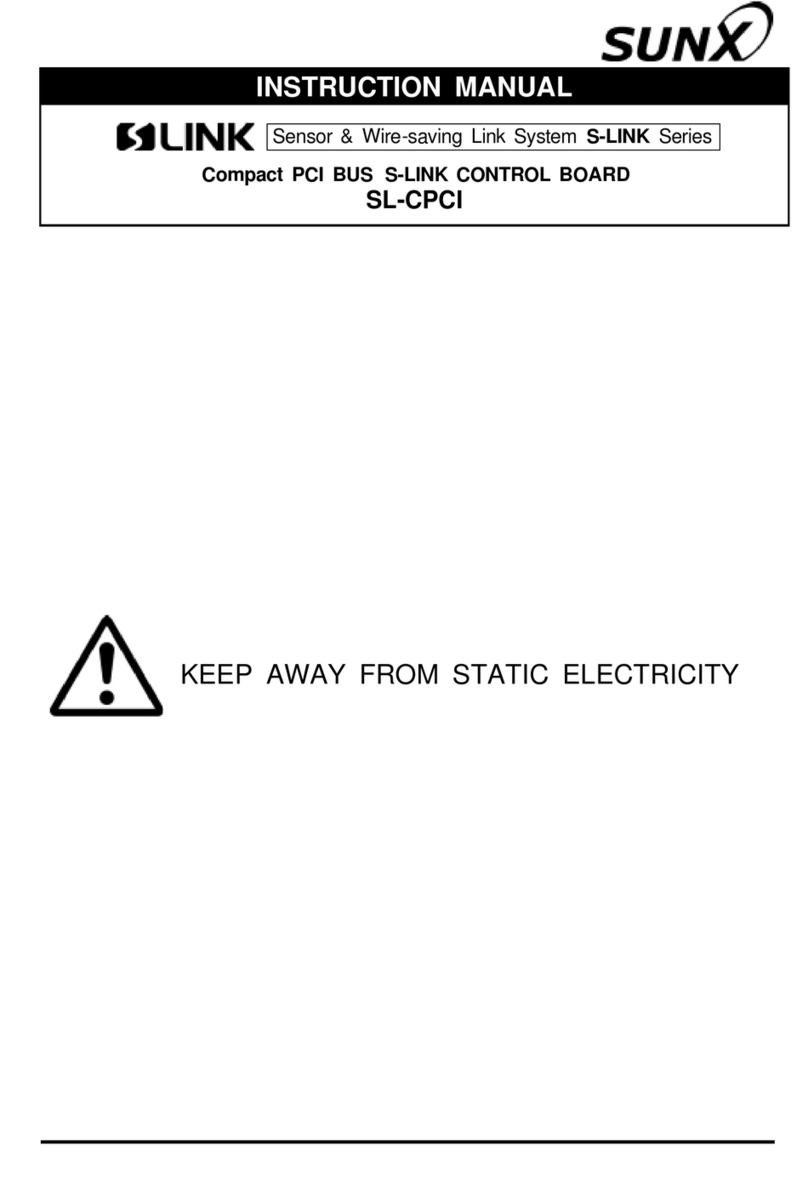Direct Healthcare Services Dyna-Form Air Suresse 220DIO 4 pipe Manual

1
Control Unit
220DIO 4 pipe
SERVICE PROCEDURES

2
Contents 220DIO 4 pipe Control Unit
Control Unit 3
Internal Descriptions 4
Basic System Checks 5
Fuse Check and Replacement 6
Printed Circuit Board (PCB) Check 7
Printed Circuit Board (PCB) Replacement 9
Standard Pressure Test 10
Double Compressor Replacement 13
Synchronous Motor Replacement 15
Connector Plate Replacement 18
Air Filter Maintenance 20
Rubber Feet Replacement 21
Hanging Hook Replacement 23
Troubleshooting 25
Safety 28
Care & Cleaning 29
Definition of Symbols Used 31
Technical Specifications 31
Declarations 32
SERVICE PROCEDURES

3
The following section outlines the steps and
procedures to follow if there is a suspected fault in
the Control Unit.
Any fault or damage to the product that is not
discussed in these Service Procedures is deemed
a non serviceable issue. The faulty product must
be returned to the Manufacturer for repair or
replacement.
If a repair seems unmanageable or the issue falls
outside the scope of serviceable repairs,
please return the Control Unit to the Manufacturer.
SERVICE PROCEDURES
220DIO 4 pipe Control Unit
Malfunction of the Control Unit may be due to the failure of one
of the replaceable electrical components of the Control Unit,
including the double compressor, print circuit board and timing
motor rotary valve.
Alternatively, a lack or loss of system pressure can be attributed
to a variety of causes, including an incorrectly attached CPR Tag;
a loosely connected or leaking Air Cell; leaking Air Pipe; or faulty
fuse. Insufficient system pressure is identified when the Alarm
LED flashes, and the corresponding Pressure Setting alarm
signals display.
Should the Control Unit fail to operate, or system pressure fail to
reach normal operating status, please follow the steps below to
isolate the cause of the problem and make the relevant repair.

4
SERVICE PROCEDURES
220DIO 4 pipe Control Unit
The electronically controlled Control Unit provides the air supply
to the Mattress. The unit is operated by a digital touch membrane
on the front display panel which controls eight comfort pressure
settings; Alternating or Static Mode for treatment or transfers
respectively; Max Firm mode for rapid inflation to maximum
pressure to create a firm surface; and Control Unit Lockout to
prevent accidental changes to the settings. The Alarm LED
indicator and Alarm Mute completes the operator controls. The
visible and audible alarm function has a number of LED indication
sequences depending on the cause of the failure.
On the side of the unit are four air connectors for quick
connection to the four hole handle. The mains supply to the unit
can be easily disconnected and is designed to detach if pulled
too firmly – protecting the internal wiring from damage.
The quality of the Control Unit underpins the reliability and
pressure reduction capabilities of the System. At the centre of
the Control Unit lies the double compressor, which runs at a rapid
and continuous rate whenever the unit is operational. Continuous
rapid movement places compressor materials under high stress
and heat conditions, which can make the unit susceptible to
wear and tear over a long period of time.
To minimise noise and vibration, the compressor is mounted to
a strong metal bracket, secured on two sides by rubber mounts.
These mounts serve to insulate the rest of the unit from the
vibration of the compressor.
Power Socket
(IEC Connector)
Printed Circuit Board
(PCB)
Rubber Feet
Static Actuator
Alternation Timer Motor
Compressor Bracket
Double Compressor
Alarm Speaker
Safety Fuse
Four Air Pipe Connector
Air Connector Plate

5
SERVICE PROCEDURES
Basic System Checks 220DIO 4 pipe Control Unit
Before commencing any service procedure, the following basic checks should be completed to ensure that system fault or failure is
not due to an oversight on behalf of the user. Set up the system and check the following:
1Ensure all power cords
and leads are firmly
attached and that the system
is connected to a working
power source (with correct
voltage).
2Check the Handle is
securely attached to
the Control Unit - all four
connectors should be firmly
inserted.
3Remove the Mattress
Top Cover and check the
CPR Tag is firmly connected. 4Check each Air Cell
and/or Side Bolster is
firmly connected to the
internal air pipe/s.
Once these simple checks are
complete, proceed with the
service and repair as outlined
in the following procedures.
FIXED
YES
YES
NO
Control Unit
is inoperable
(Display Panel fails to activate when
unit is connected to a power source)
YES
FIXED
FIXED
FIXED
NOT FIXED
STILL LOW
PRESSURE
PRESSURE
OK
CHECK FAILS
OTHER PROBLEM
NO
Fuse Check and
Replacement
Printed Circuit
Board (PCB)
Check
Basic System Checks
(check power & power cords;
Air Hose Attachments;
CPR Tag;
Air Cell attachment)
Control Unit is
operational but the
motor is ‘grinding’
or making an unusual sound
Control Unit is
operational but
fails to reach operation
pressure or loses pressure
STILL
INOPERABLE
CONFIRMS
FAULTY PCB FIXED
FIXED
Return to
Manufacturer
Return to
Manufacturer
Return to
Manufacturer
PCB Replacement
Standard
Pressure Test Air Leak Test
Air Cell
Replacement
Compressor
Replacement
Synchronous
Motor
Replacement
PRESSURE
NOT OK
PRESSURE
OK
NOT
FIXED
DEFLATING
Service Procedure Flowchart
Follow the flowchart to establish the recommended steps for system check and repair.

6
Testing fuse for damage and replacing a blown fuse
Control Unit failure may be the result of a blown fuse. Always check the fuse before opening the unit and performing any
other internal component test procedures.
Note: When changing the replaceable fuse, use same rating fuse only (T1AL/250V).
The following tools are
required:
•Flat Head Screwdriver
The following replacement
parts are required:
•250V fuse
Switch off power supply
to the Control Unit and
remove the power cord from
the electrical socket in the
base of the unit.
Using a level surface,
place the Control Unit
on its base, with easy access
to the black round fuse cap
located on the side of the unit
(closest to the connectors).
Insert a small screwdriver
into the groove on the
fuse cap and turn counter-
clockwise in the direction of the
arrow (quarter turn) to remove
the fuse plug and single fuse.
Visually inspect the fuse –
check if the metal filament
inside the fuse cylinder is
disconnected or snapped –
and discard if damaged
(or re-insert if undamaged).
Insert a new fuse (or the
undamaged fuse) into the
plug. Push against the force of
the spring and turn clockwise
with the screwdriver (quarter
turn).
Reconnect the power
cord to the Control Unit
and switch on power supply.
If Control Unit still fails to
operate, the problem may be
due to a faulty circuit board.
Proceed to Printed Circuit
Board Check procedure.
If the unit switches on but fuse
“blows” again, repeat the steps
to replace the damaged fuse
but do not reconnect power
as damage may be due to a
faulty compressor. Proceed
to Standard Pressure Test
procedure.
SERVICE PROCEDURES
Fuse Check and Replacement 220DIO 4 pipe Control Unit

7
Testing for a faulty circuit board by ‘piggybacking’ a working spare
If the Control Unit still fails to operate after checking and replacing a damaged fuse, the next step is to test the Printed Circuit Board
(PCB) for failure.
To determine if the PCB has failed, always test the Control Unit using a working spare.
When handling the PCB, anti-static gloves (or other anti-static precautions) should be used to protect the PCB from static.
The following tools are
required:
•Phillips Head Screwdriver
•Wire Clippers
The following spare parts are
required:
•1 x PCB
(in known working
condition)
Switch off power supply
to the Control Unit,
disconnect the Air Pipes and
remove the power cord from
the electrical socket in the
base of the unit.
Using a soft cloth to
protect the unit from
damage, place the Control Unit
on a level work surface with
base facing upwards.
Use a Phillips Head
Screwdriver to remove
the four screws that secure
the housing. Place the screws
and washers in a safe place
(such as small container or
jar) to prevent loss. Hold the
unit firmly and turn it over, face
upwards on its base.
Gently loosen the top and
bottom housing. Once
loose, hold the power socket
(IEC connector) to prevent
from catching while lifting the
top cover and leaning it back
on your work surface.
Be careful not to drag the
internal wires and tubing
during this process. Before
continuing, ensure no electrical
leads are stretched and that
all electrical connectors on the
Printed Circuit Board (PCB)
are firmly connected. You may
need to prop the top housing
case to prevent strain on the
electrical cords.
Disconnect the four
electronic power leads
by cutting the cable ties that
secure the leads to the PCB.
Carefully pull the plastic casing
(not the wiring) to disconnect.
Disconnect the remaining
three connections from
the PCB (two flat digital leads
and one air tube). Be sure to
note the location of all seven
connections on the circuit
board for easy replacement.
Leave the disconnected PCB
in the Control Unit during
testing.
SERVICE PROCEDURES
Printed Circuit Board (PCB) Check 220DIO 4 pipe Control Unit

8
Take the working spare
PCB and reconnect
all seven leads into the
corresponding connectors
(four electronic leads; two
digital; one air pipe).
Reconnect mains power,
switch on the Control Unit
and check the Display Panel.
If the unit now operates, the
internal PCB has failed and
needs replacing. Proceed
to the Printed Circuit Board
Replacement procedure for
next steps.
If the Control Unit still
does not operate, the unit
needs to be returned to the
Manufacturer for further repair
or replacement.
Switch off power supply
to the Control Unit,
remove the spare PCB and
reconnect the internal PCB
(reconnect the seven power
leads to the circuit board)
before closing the housing.
Return the Control Unit
to the Manufacturer in
accordance with standard
procedures.
SERVICE PROCEDURES
Printed Circuit Board (PCB) Check 220DIO 4 pipe Control Unit

9
Replacing a faulty circuit board
Having established a fault with the PCB by following the Printed Circuit Board Check procedure detailed previously
(steps 1 through 7), replace the faulty PCB with a new PCB.
When handling the PCB, anti-static gloves (or other anti-static precautions) should be used to protect the PCB from static.
The following tools are
required:
•Needle Nosed Pliers
•Phillips Head Screwdriver
The following replacement
parts are required:
•1 x PCB
Switch off power supply
to the Control Unit before
disconnecting the spare ‘test’
PCB. Disconnect all seven
leads while noting the location
of each lead on the circuit
board.
Using Needle Nosed
Pliers, unclip the PCB
from the top housing. Note the
orientation of the PCB before
removing it from the unit.
Dispose of the faulty PCB in an
environmentally safe manner.
Unpack the
replacement PCB.
Align the circuit board against
the four holes and carefully
reconnect the clips by pressing
firmly into place.
Reconnect all
seven leads into the
corresponding connectors on
the circuit board.
Before closing the
housing, make sure
all power leads and pipes
are free from the side edges.
Ensure the regulator tubing will
not kink when the top cover is
closed.
Align the top and
bottom housing
before slowly pushing
closed. Ensure the seal is
properly aligned around the
housing, including the air pipe
connectors, fuses and power
connector.
Holding the top and
bottom housing firmly
together, turn the Control Unit
upside down, with base facing
upwards.
Use a Phillips Head
Screwdriver to
replace the four screws plus
washers and tighten to secure
the housing together.
Connect the Control
Unit to mains power
and switch on the Control Unit
to confirm operation.
SERVICE PROCEDURES
Printed Circuit Board (PCB) Replacement 220DIO 4 pipe Control Unit

10
Testing airflow and checking for a faulty compressor
The Control Unit double compressor is designed for long life, and backed by a two-year warranty from the Manufacturer, however
compressor failure can occur and will require replacement.
The Standard Pressure Test should be carried out to check the compressor is working at full operational capacity and that sufficient
airflow is being generated to maintain maximum Mattress specifications. By directly connecting the compressor to the Pressure Test
Equipment (Sphygmomanometer and Air Flow Meter), this test will confirm system pressure readings at maximum and minimum
airflow (in free flow mode or with different degrees of back pressure applied). If the Pressure Test fails and pressure readings do not
match required settings, the compressor should be replaced and the test repeated.
The Control Unit must be allowed to “warm up” before undertaking the Standard Pressure Test, to ensure the diaphragm inside the
compressor has loosened and is operating at maximum capacity. After opening the unit, reconnect power and allow the system to
run for a minimum of thirty minutes before commencing this test.
The following tools are
required:
•Phillips Head Screwdriver
•Pressure Test Equipment
>Sphygmomanometer
(mmHg reading)
>Air Flow Meter
(Lpm reading)
Using a soft cloth to
protect the unit from
damage, place the Control Unit
on a level work surface with
base facing upwards.
Use a Phillips Head
Screwdriver to remove
the four screws that secure
the housing. Place the screws
and washers in a safe place
(such as small container or
jar) to prevent loss. Hold the
unit firmly and turn it over, face
upwards on its base.
Gently loosen the top and bottom housing. Once loose,
hold the power socket (IEC connector) to prevent from
catching while lifting the top cover and leaning it back on your
work surface.
Be careful not to drag the internal wires and tubing during this
process. Before continuing, ensure no electrical leads are
stretched and that all electrical connectors on the Printed Circuit
Board (PCB) are firmly connected. You may need to prop the top
housing case to prevent strain on the electrical cords.
Pressure Test Equipment Set Up
One air pipe is connected to the rear of the Sphygmomanometer
and another to the base of the Air Flow Meter. These two air pipes
are then connected by a ‘Y’ piece to form a single air pipe outlet.
Check all pipe attachments are secure before commencing the
test. Initially set the equipment to free flow mode – ensure the
airflow valve at the front of the Air Flow Meter is fully open (turn the
valve clockwise to open).
Switch off power supply
to the Control Unit,
disconnect the Air Pipes and
remove the power cord from
the electrical socket in the
base of the unit.
SERVICE PROCEDURES
Standard Pressure Test 220DIO 4 pipe Control Unit

11
To check operational capacity
of the double compressor,
test each pressure setting as
outlined in the following steps.
The table above summarises
the expected pressure and air
flow measurements. If air flow
measurements fail to meet the
specifiedminimumlevelsduring
any stage of the pressure test,
the double compressor is not
operating at full capacity and
needs to be replaced.
Remember that a 30 minute
“warm up” period is required.
Ensure the equipment
is set to ‘free flow mode’
(i.e. no resistance or back
pressure against the full flow of
air from the compressor). The
valve at the front of the Air Flow
Meter should be fully open. If
not, turn clockwise to open the
valve to maximum. With the
system in free flow mode, the
ball bearing inside the Air Flow
Meter should rise to a minimum
of 9+ litres per minute. The
Sphygmomanometer pressure
reading should be low
(approximately 10 mmHg).
Slowly close the valve
on the Air Flow Meter
to reduce airflow air and
simulate ‘back pressure’ (i.e. to
emulate the weight of a patient
lying on the mattress, which
forces pressure back against
the flow of air from the unit).
Slowly close the valve until the
Sphygmomanometer pressure
reading reaches 30 mmHg.
At 30 mmHg, the ball bearing
inside the Air Flow Meter
should drop to a minimum of
6+ litres per minute.
Continue to increase
back pressure resistance.
Slowly close the valve on
the Air Flow Meter until the
Sphygmomanometer pressure
reading reaches 60 mmHg.
At 60 mmHg, the ball bearing
inside the Air Flow Meter
should drop to a minimum of
4+ litres per minute.
Finish testing by fully
closing the Air Flow Meter
valve (maximum resistance).
The ball bearing inside the Air
Flow Meter should drop to 0
and the Sphygmomanometer
pressure reading should rise to
120+ mmHg.
Reconnect the Control
Unit to mains power and
switch on. The unit must run
for a minimum of 30 minutes
to “warm up” before pressure
testing commences. Leave the
unit in a safe place during the
warm up period.
After the 30 minute
“warm up” period
has elapsed, detach the
internal air pipe from the
compressor (some force may
berequired) and replace with
the air pipefrom the Pressure
Test Equipment (for directly
connection to the compressor).
Push the air pipe firmly until it fully
covers the connector.
m
a
y
aya
h
SERVICE PROCEDURES
Standard Pressure Test 220DIO 4 pipe Control Unit
Base
Pressure
mmHg
Air Flow
Lpm
>10 9+
30 6+
60 4+
120> 0
30
open
4.5+
10 3+
60
2+
close
0
120+

12
If air flow measurements
fail to meet the specified
minimum levels during any
stage of the pressure test,
the double compressor is not
operating at full capacity and
needs to be replaced. Proceed
to Double Compressor
Replacement procedure.
If all pressure and air flow
measurements met the
expected levels, the problem
may be due to a leaking Air
Cell or other defect with the
Mattress. Close the Control
Unit and proceed to Mattress
procedures.
To close the Control
Unit, first disconnect the
Pressure Test Equipment air
pipe from the compressor
and reattach the internal air
pipe, using gentle pressure to
ensure a firm fit.
Before closing the
housing, make sure all
power leads and pipes are free
from the side edges. Ensure
the regulator tubing will not
kink when the top cover is
closed.
Align the top and bottom
housing before slowly
pushing closed. Ensure the
seal is properly aligned around
the housing, including the air
pipe connectors, fuses and
power socket.
Holding the top and
bottom housing firmly
together, turn the Control Unit
upside down, with base facing
upwards.
Use a Phillips Head
Screwdriver to
replace the four screws plus
washers and tighten to secure
the housing together.
Connect the Control
Unit to mains power
and switch on the unit to
confirm operation.
SERVICE PROCEDURES
Standard Pressure Test 220DIO 4 pipe Control Unit

13
Replacing a faulty compressor
Having established a fault with the compressor by following the completing the Standard Pressure Test procedure detailed previously
(steps 1 through 6), replace the faulty compressor with a new one.
The following tools are
required:
•Wire Clippers (or sharp
knife)
•Needle Nosed Pliers
•Phillips Head Screwdriver
The following replacement
parts are required:
•1 x Double Compressor
•1 x Cable Tie
Switch off power supply
to the Control Unit and
remove the power cord
from the electrical socket in
the base of the unit before
disconnecting the Pressure
Test Equipment air pipe.
Using Wire Clippers (or
a sharp knife) carefully
cut and remove the cable
tie securing the power leads
between the two halves of the
unit.
Disconnect the power lead
from the PCB.
Disconnect both air pipes from
each compressor.
Lift the faulty double
copressor free of the
bracket and dispose of in an
environmentally safe manner.
Unpack the
replacement double
compressor and realign
as previous (ensure the
powerlead is closest to the
PCB).
Secure the double
compressor to the
metal bracket by reconnecting
the twelve rubber mounts,
starting with ten base mounts
then four top mounts.
For the sake of alignment,
it is easier to start withthe
rubber mounts secured to the
bracket, then insert the other
end into the corresponding
holes in the double
compressor before securing.
Gently push through the hole
until the mount can be twisted
around the nose of pliers and
pulled firmly into place.
SERVICE PROCEDURES
Double Compressor Replacement 220DIO 4 pipe Control Unit
Extract each of the twelve
rubber mounts that secure the
compressor to the metal bracket.
It is easier to extract each mount
using a pair of needle nosed pliers
to gently twist free rather than
pulling directly with force.
If rubber mounts break, make sure
all pieces are removed from inside
the unit. Undamaged mounts can
be reused.

14
Visually check
that each mount
is attached and the double
compressor is correctly
secured to the metal bracket.
Reattach both
air pipes to each
compressor, using gentle
pressure to ensure a firm fit.
Reconnect the
compressor power
lead to the circuit board and
attach a new cable tie to
secure all power leads as
before.
Before closing the
housing, make sure
all power leads and pipes
are free from the side edges.
Ensure the regulator tubing will
not kink when the top cover is
closed.
Align the top and
bottom housing
before slowly pushing
closed. Ensure the seal is
properly aligned around the
housing, including the air pipe
connectors, fuses and power
connector.
Holding the top and
bottom housing firmly
together, turn the Control Unit
upside down, with base facing
upwards.
Use a Phillips Head
Screwdriver to
replace the four screws plus
washers and tighten to secure
the housing together.
Connect the Control
Unit to mains power
and switch on the Control Unit
to confirm operation.
SERVICE PROCEDURES
Compressor Replacement 220DIO 4 pipe Control Unit

15
Replacing a faulty synchronous motor
The synchronous motor runs the rotovalve that operates the timing mechanism for the alternation cycle. If the rotovalve becomes
worn or damaged it no longer spins smoothly and the unit will emit a distinct ‘grinding’ noise.
If you hear an uncharacteristic noise from the motor when the Control Unit is switched on, the synchronous motor needs to be
replaced.
The following tools are required:
•Phillips Head Screwdriver
•Wire Clippers (or sharp knife)
•Flat Head Screwdriver (small)
•7/32 Inch Socket Wrench
The following replacement
parts are required:
•1 x Synchronous Motor
(M8260147)
•1 x Cable Tie
Gently loosen the top and
bottom housing. Once
loose, hold the power socket (IEC
connector) to prevent from catching
while lifting the top cover and leaning
it back on your work surface.
Be careful not to drag the internal
wires and tubing during this process.
Before continuing, ensure no
electrical leads are stretched and
that all electrical connectors on the
Printed Circuit Board (PCB) are firmly
connected. You may need to prop
the top housing case to prevent
strain on the electrical cords.
Using Wire Clippers
(or a sharp knife)
carefully cut and remove
the cable tie securing the
power leads between
the two halves of the unit.
Trace the power lead
running from underneath
the synchronous motor to
its connection on the circuit
board. Disconnect this lead
from the circuit board by
carefully pulling the plastic
casing (not the wiring) and
gently remove the lead from
under the compressor cage
and leave it free.
Using thumb and
forefinger, push down
firmly on the plastic rotovalve
casing to release tension
while removing the split pin – a
deal of downward pressure
is required. While maintaining
downward pressure, take a
small screwdriver or other
implement to gently lift the split
pin from the top of the motor
shaft. Place the pin in a safe
place for future replacement.
SERVICE PROCEDURES
Synchronous Motor Replacement 220DIO 4 pipe Control Unit
Switch off power supply
to the Control Unit,
disconnect the Air Pipes and
remove the power cord from
the electrical socket in the
base of the unit.
Using a soft cloth to
protect the unit from
damage, place the Control Unit
on a level work surface with
base facing upwards.
Use a Phillips Head
Screwdriver to remove
the four screws that secure
the housing. Place the screws
and washers in a safe place
(such as small container or
jar) to prevent loss. Hold the
unit firmly and turn it over, face
upwards on its base.

16
11Lift the motor off its
mounts and remove,
ensuring the power lead does
not get caught in the process.
Dispose of the faulty motor
in an environmentally safe
manner.
12Unpack the
replacement motor.
Carefully thread the power
lead under the base of the
compressor cage before
repositioning the new motor
over the shaft and on its
mounts, ensuring bolt holes
are correctly aligned.
13Replace the ‘L’
shaped metal bracket
over the bolt hole closest to
the compressor – it must be
positioned to accommodate
the plastic handle on the
rotovalve. If not correctly
positioned, the rotovalve will
move during operation.
L
The rotovalve is made of two
plastic circular casings held
together by lubricant material,
and should remain attached
during removal. If the top
casing comes free during
this process, place in a safe
place until time to replace
the rotovalve, when it can be
reattached.
8Gently lift the plastic
rotovalve up and over the
shaft, sliding the ‘L’ shaped
metal bracket through the
black plastic handle at the side
of the rotovalve, to reveal the
spring and synchronous motor
beneath.
9Remove the spring and
place it in a safe place for
future replacement.
SERVICE PROCEDURES
Synchronous Motor Replacement 220DIO 4 pipe Control Unit
10Using the socket
wrench, unscrew the
two bolts that hold the motor
in place, noting the position
of both the bolts and the ‘L’
shaped metal bracket (closest
to the compressor). This
bracket helps secure the plastic
rotovalve casing to the motor
and should also be removed
and placed in a safe place with
bolts for future replacement.
14To test correct alignment
of the motor and bracket,
insert both bolts to secure the
motor but finger tighten only.
Gently place the rotovalve over
the shaft to check the ‘L’ shaped
bracket is correctly positioned to
slide through the plastic handle
at the side of the rotovalve. Once
alignment is verified, remove the
rotovalve and using the 7/32 inch
socket wrench, tighten both bolts
to firmly secure the motor in place.
Be careful not to overtighten.

17
Reposition the spring
over the shaft, wider
coils at the base (finer coils
on top).
If the top plastic
casing of the
rotovalve has come lose,
reposition it and hold firmly
in place before replacing the
rotovalve over the shaft, while
sliding the ‘L’ shaped bracket
through the plastic handle at
the side of the rotovalve.
Firmly push down
on the rotovalve
while replacing the split pin
through the top of the shaft. A
significant amount of pressure
is required to counteract the
force of the spring.
Reconnect the motor
power lead to the
circuit board and attach a new
cable tie to secure all power
leads as before.
Test the motor before
closing the housing.
Connect the Control Unit to mains
power and switch on to ensure the
motor works and rotovalve is turning
(with no adverse noise).
It the Control Unit fails to operate,
the unit needs to be returned to
the Manufacturer for further repair
or replacement. Switch off power
supply to the Control Unit before
closing the housing. Return the
Control Unit to the manufacturer in
line with standard procedures.
Before closing
the housing,
make sure all power leads
and pipes are free from
the side edges. Ensure the
regulator tubing will not
kink when the top cover is
closed.
Align the top and
bottom housing
before slowly pushing
closed. Ensure the seal is
properly aligned around the
housing, including the air pipe
connectors, fuses and power
connector.
Holding the top and
bottom housing firmly
together, turn the Control Unit
upside down, with base facing
upwards.
Use a Phillips Head
Screwdriver to
replace the four screws plus
washers and tighten to secure
the housing together.
Connect the Control
Unit to mains power
and switch on the Control Unit
to check function.
SERVICE PROCEDURES
Synchronous Motor Replacement 220DIO 4 pipe Control Unit

18
Replacing the air pipe connectors
Each of the four connectors on the side of the Control Unit can be removed and replaced in the event of damage or breakage.
In the event of more significant damage to the external plate that houses the four connectors, proceed to theConnector Plate
Replacement procedure.
Gently loosen the top and
bottom housing. Once
loose, hold the power socket
(IEC connector) to prevent
from catching while lifting the
top cover and leaning it back
on your work surface.
Be careful not to drag the
internal wires and tubing
during this process. Before
continuing, ensure no electrical
leads are stretched and that
all electrical connectors on the
Printed Circuit Board (PCB)
are firmly connected. You may
need to prop the top housing
case to prevent strain on the
electrical cords.
Gently loosen the
Connector Plate from the
side of the unit and hold firmly
in one hand.
Remove the damaged
connector from the
Connector Plate by holding
the base of the connector (at
top of air pipe) and twisting
counter clockwise to release
the locking mechanism.
The following tools may be
required:
•Phillips Head Screwdriver
The following replacement
parts are required:
•Connector
Switch off power supply
to the Control Unit,
disconnect the Air Pipes and
remove the power cord from
the electrical socket in the
base of the unit.
Using a soft cloth to
protect the unit from
damage, place the Control Unit
on a level work surface with
base facing upwards.
Use a Phillips Head
Screwdriver to remove
the four screws that secure
the housing. Place the screws
and washers in a safe place
(such as small container or
jar) to prevent loss. Hold the
unit firmly and turn it over, face
upwards on its base.
SERVICE PROCEDURES
Connector Replacement 220DIO 4 pipe Control Unit

19
8Detach the air pipe from
the damaged connector
by pulling firmly. Unpack the
replacement connector and
press firmly to reattach the
internal air pipe as before.
Ensure the pipe is secure and
fully buttressed against the
base of the connector.
You may want to carefully secure
pipe using a gentle adhesive
tape or cable tie to bind.
9Refit the connector to the
Connector Plate, twisting
clockwise to lock into place.
Repeat this process for other
damaged connectors.
10Reposition the
Connector Plate into
the side of the control unit.
Ensure the Connector Plate
retains the correct orientation,
with the groove (that aligns
with the tongue on the Handle)
positioned towards the top
housing. This ensures the
correct orientation of the
Handle is maintained.
11Before closing the
housing, make sure
all power leads and pipes
are free from the side edges.
Ensure the regulator tubing will
not kink when the top cover is
closed.
12Align the top and
bottom housing
before slowly pushing
closed. Ensure the seal is
properly aligned around the
housing, including the air pipe
connectors, fuses and power
connector.
13Holding the top and
bottom housing firmly
together, turn the Control Unit
upside down, with base facing
upwards.
14Using the Phillips
Head Screwdriver to
replace the four screws plus
washers and tighten to secure
the housing together.
SERVICE PROCEDURES
Connector Replacement 220DIO 4 pipe Control Unit

20
Replacing the Connector Plate
If the sunken Connector Plate is cracked or damaged it must be replaced.
Gently loosen the top and
bottom housing. Once
loose, hold the power socket
(IEC connector) to prevent
from catching while lifting the
top cover and leaning it back
on your work surface.
Be careful not to drag the
internal wires and tubing
during this process. Before
continuing, ensure no electrical
leads are stretched and that
all electrical connectors on the
Printed Circuit Board (PCB)
are firmly connected. You may
need to prop the top housing
case to prevent strain on the
electrical cords.
Gently loosen the
Connector Plate from the
side of the unit and hold firmly
in one hand.
Detach all four
connectors from the
Connector Plate by holding
the base of each connector
(at top of air pipe) and twisting
counter clockwise to release
the locking mechanism. Be
careful to maintain the correct
order of the pipes or alternation
sequence will be incorrect.
The following tools may be
required:
•Phillips Head Screwdriver
The following replacement
parts are required:
•Connector Plate
Switch off power supply
to the Control Unit,
disconnect the Air Pipes and
remove the power cord from
the electrical socket in the
base of the unit.
Using a soft cloth to
protect the unit from
damage, place the Control Unit
on a level work surface with
base facing upwards.
Use a Phillips Head
Screwdriver to remove
the four screws that secure
the housing. Place the screws
and washers in a safe place
(such as small container or
jar) to prevent loss. Hold the
unit firmly and turn it over, face
upwards on its base.
SERVICE PROCEDURES
Connector Plate Replacement 220DIO 4 pipe Control Unit
Table of contents
Popular Control Unit manuals by other brands
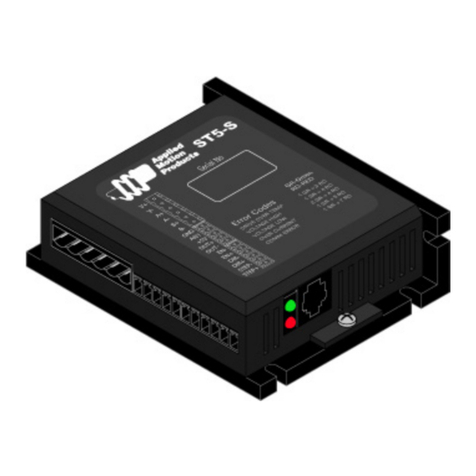
Moons'
Moons' Applied Motion Products ST5-S Hardware manual
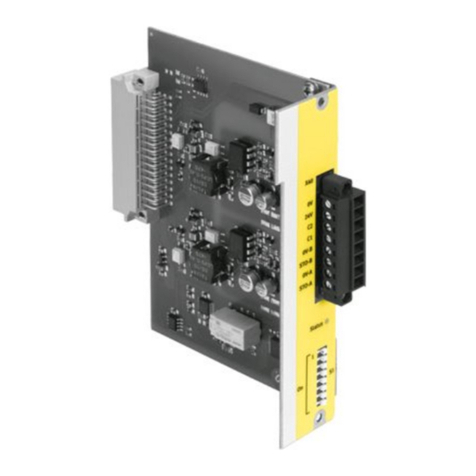
Festo
Festo CAMC-G-S1 manual

EOS
EOS ECON 45A1 Assembly and operating instruction
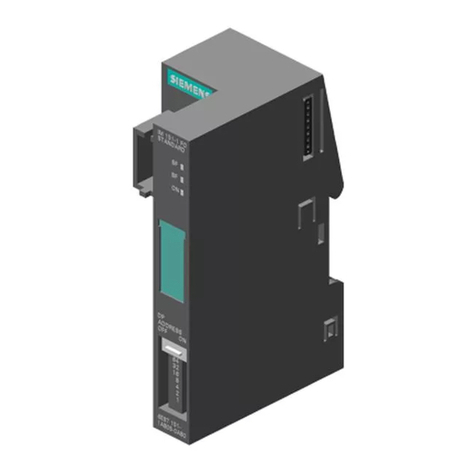
Siemens
Siemens SIMATIC ET 200S IM151-1 FO STANDARD manual
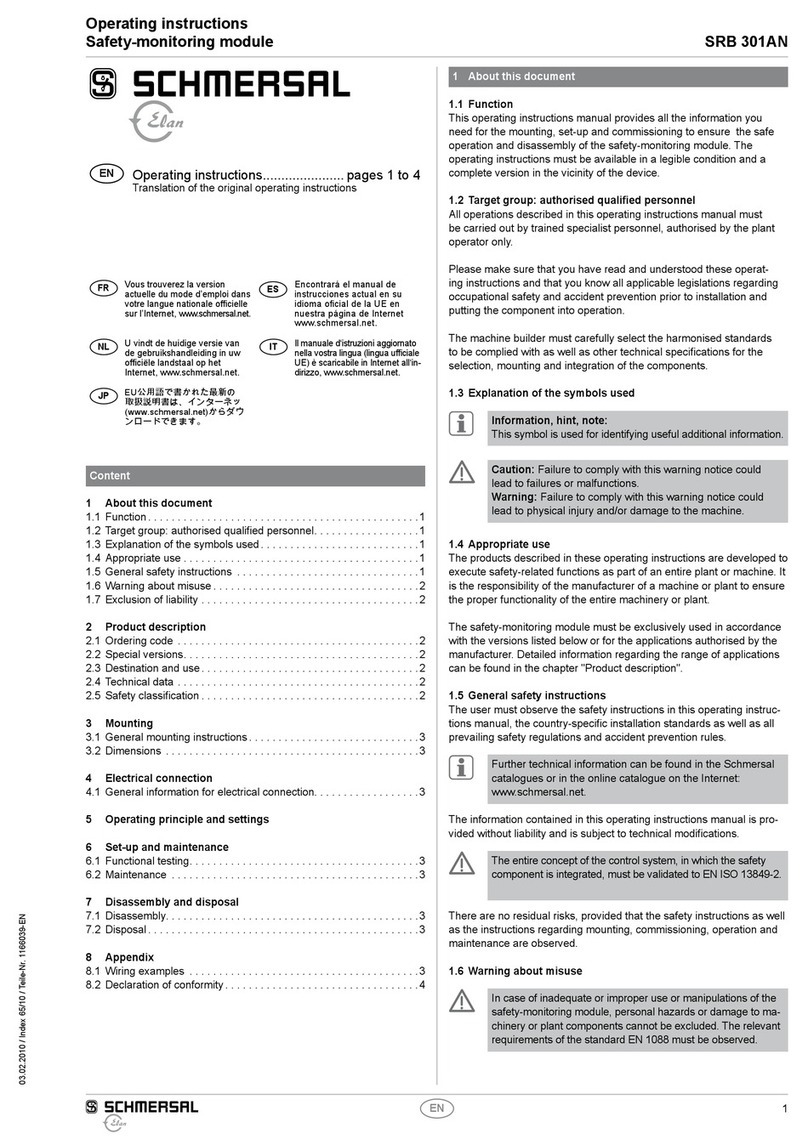
schmersal
schmersal SRB 301AN operating instructions

Emerson
Emerson K-BALL F110 Operating and safety instructions


